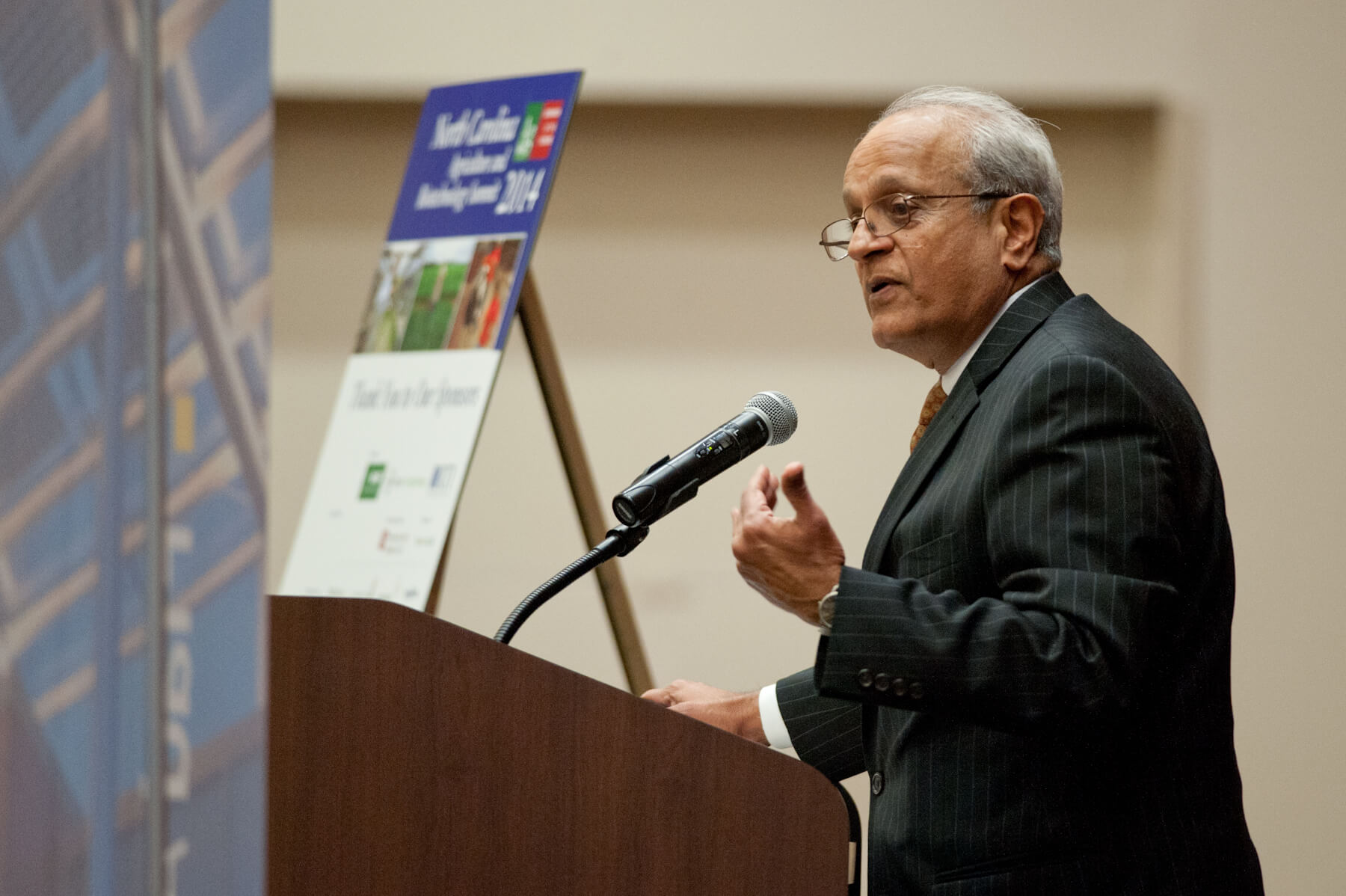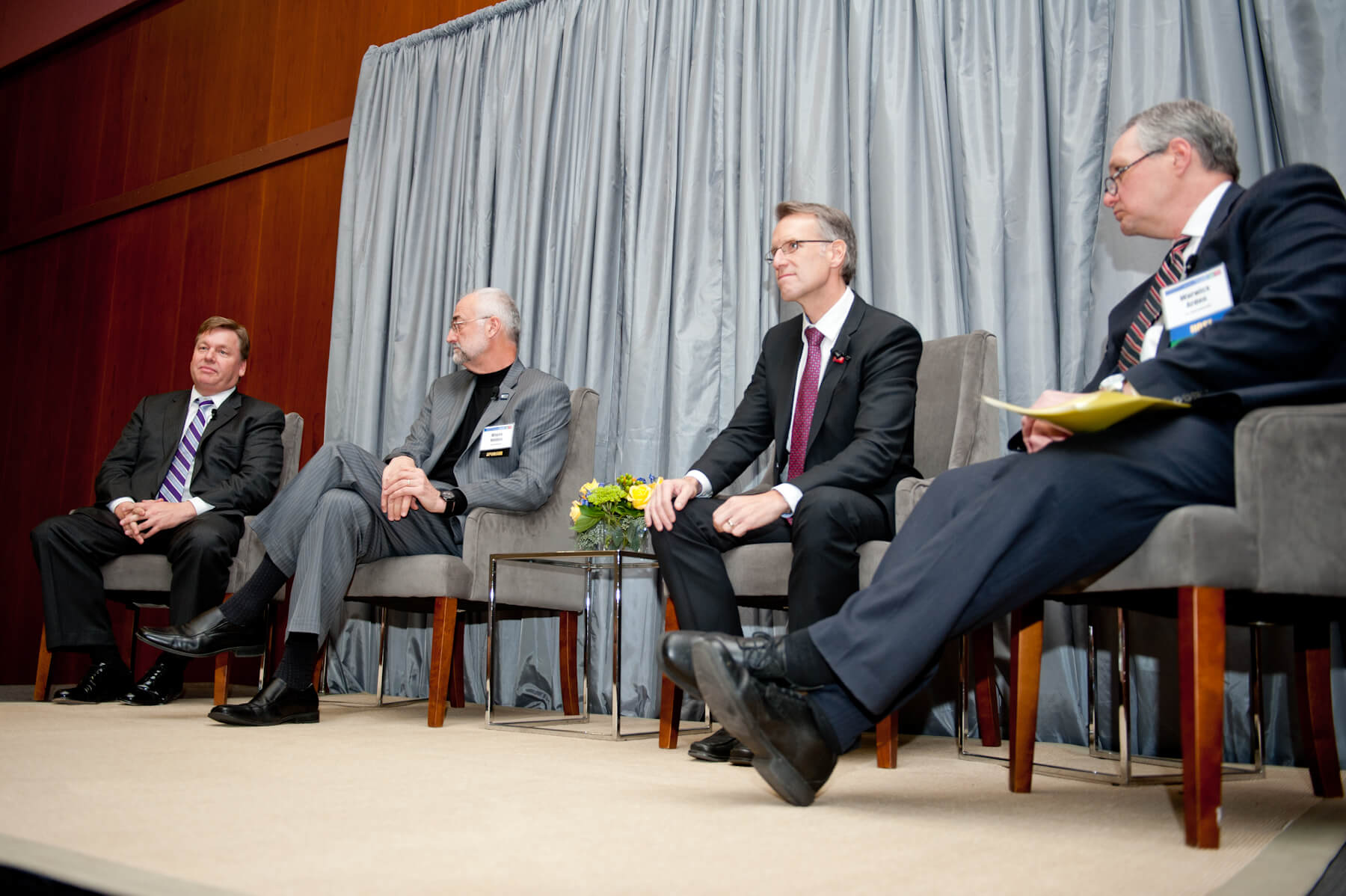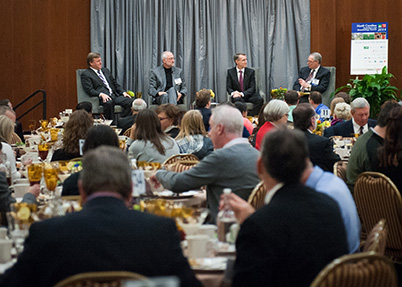
Leaders, Thinkers, Students, Researchers Gather for Ag + Biotech Summit
|
|
|
Photo courtesy of NC State University |
More than 500 participants in the NC State University College of Agriculture and Life Science and NCBiotech Ag Biotech Initiative joint North Carolina Agriculture and Biotechnology Summit are dealing with the challenge of feeding 9 billion people by the year 2050. And more.
Participants have been exploring a dazzling array of topics, from the technologies needed to meet global demand, to the necessity for understanding the nuances involved in consumer acceptance of those technologies. The full agenda is here.
Follow the summit's Twitter traffic at (#AgBioSummit14) and/or read staff vignettes from the conference (below).
The Mythbuster
In his introduction, consultant Steve Savage, Ph.D., was called a mythbuster.
The best way to bust a myth is to share facts. Savage’s topic was genetic modification in crops. So Savage, with a long history in ag biotech and now an independent communicator and consultant, shared some facts about GMOs:
- Soybeans enjoy wide acceptance
- Cotton has the greatest geographic diversity
- There are 14 different crops, with 352 instances of traits introduced.
- Traits fall into several categories: herbicide tolerance, insect or disease resistance, pigmentation, drought resistance, shelf life and even nutritional benefits.
He covered the barriers that existed as genetically modified crops were being created. And turned to the two issues that remain: regulation pathways and food system acceptance.
Out of the first barrier, Savage coined a term, Green Imperialism. He explained that rich, and well-fed, nations are projecting their precaution in regulating crops onto the developing world.
Savage took a different approach to navigating the second obstacle. He said the community has never had “so many voices out there for opening up some of the possibilities that have been blocked.” And instead of telling those in the crowd what to say, he gave them some things not to say:
- Don’t claim biotech crops will feed the world. They are part of feeding the world. Farmers will feed the world, with these and other tools.
- Don’t go along with societal myths and misconceptions, which use some of these terms:
- Industrial Agriculture
- Corporate Farming
- Evil corporations
- Monoculture
- Don’t let people link the use of pesticides, or the presence of a substance, like trans-fats, with GMOs.
Check out #AgBioSummit for more.
Wicked Problems
Sonny Ramaswamy, Ph.D., director of the National Institute of Food and Agriculture at USDA, took the stage during lunch with a big question to answer.
Can plants do everything? A survey of his colleagues in various disciplines yielded a range of answers.
 |
|
Photo courtesy of NC State University |
Plant scientists? Sure. Sociologists? Well…
Ramaswamy said his answer is a qualified yes. And at the center of it all, he sees food.
Not because it is all that plants can produce. But because the dilemma of producing the food to meet global demand (think 9 billion people in 2050; doubling our food production) has far-reaching tentacles.
- Food waste. In the U.S. we waste 1200 calories per person per day. In addition, as Americans we eat more than 3,000 calories a day when we only need 2,000 or so. It’s a low-hanging fruit in meeting that gap.
- A bio-based economy. It’s more than bio-ethanol. There’s a whole green engine that we need to unravel to really get at the potential of plant science.
- Ecological footprint. Much of the nitrogen and phosphorous used in farming runs off into surrounding water supplies.
- Healthcare. While one in six people are hungry in the U.S., one in six are also taking a prescription for high cholesterol, diabetes, hypertension and other chronic diseases - diseases which are preventable in many cases. The food that we choose to eat is creating health issues that require resources to address.
Ramaswamy’s point was that biotechnology can help to solve the food production problem - he called it the mother of all wicked problems. But other, people-based solutions are just as critical to meeting that goal.
Editor’s commentary:
Did hearing this talk at the end of lunch make anyone else feel uncomfortable? - RD
Another editor’s response (Jim Shamp, NCBiotech Director of Public Relations):
This talk was definitely "food" for thought. In fact, I finished my whole slice of cheesecake to avoid food waste, even though I originally intended to leave some on the plate. Here are my notes, some of which will overlap Robin's: -- JS
“Can plants do everything? I’m an entomologist, not a plant guy.”
So Ramaswamy asked friends, engineers, animal scientists, social scientists, across the country. “The answer I got was that plants can do many things, but not everything. So my answer is a qualified yes.”
He credited Jeff Dangl, Ph.D., a preeminent plant scientist at the University of North Carolina at Chapel Hill, for doing "a bang-up job of framing why this is critical." Energy comes from fossil fuels, formerly living plants. The clothes we wear, food we eat, autos we drive, are made of composites derived from plants.
Some other key points of Ramaswamy's talk:
- The biochemical machinery of plants has evolved. Our bio economy will unravel secrets of plant materials a lot more during the next 10 or 15 years.
- The U.S. food enterprise is $380 billion, $78 billion in North Carolina, but on the dinner table it ends up being over $2 trillion across the U.S. – over 10 percent of our GDP.
- It turns out one of best ways to treat Ebola is a vaccine grown from tobacco, called Zmapp.
- Syngenta's Mary-Dell Chilton, PhD., in the 1980s, funded by Ramaswamy's agency, helped launch the plant biotech revolution by using agrobacteria in plants.
- We have problems like the nine-plus billion population by 2050 problem. "I call them wicked problems." We have fantastic technology but we’re not able to deploy it because of human factors. Everything ends up being a head-butting situation.
- This, despite the fact that the population problem we’ve been talking about "is the mother of all wicked problems."
- And because of that, we have "baby wicked problems" like climate change. Over half the population of the U.S. doesn’t even agree that we have a problem with climate change, while many others also don’t believe humans are the cause.
- China’s one-child policy avoided 400 million mouths to feed in the next 30 years. But they did that "by holding a gun to people’s heads" But now China is facing a rapidly aging population, without young people coming in to prime their economy. So in 2014, they relaxed the one-child policy. Hang on. That will result in a population surge again in China. And by the way, other countries will be adding millions more as well.
- Water is another "baby wicked" problem. Americans have what we’ve got. Food we consume at our dinner tables takes about 80 percent of the fresh water we use. And almost half the food is lost after the dinner table, via food waste. We’re wasting 131 billion tons a food a year. In the developing world, half the food is lost before it gets to the dinner table. Overall, we’re losing one quadrillion liters of water a year just to food waste. Fifteen years from now there’ll be a 40 percent shortfall in water.

Photo courtesy of NC State University
- Right now we have low-hanging fruit regarding food waste and food loss. Milk that says “sell by” gets poured down the drain, though it can be consumed for another week or so. So imagine the savings from “sell-by, use-by” labels. We don’t need only high-falutin’ biotech solutions alone. We have low-hanging fruit in food waste already.
- 21st century food system challenges include agricultural competitiveness and an aging farmer population averaging 58 years old in the U.S. Right now we need to worry about educating more young people to go into agriculture.
- Another issue is our ecological footprint. Illinois, Indiana and Iowa are contributing 90 percent of the nitrogen to our ecosystem.
- In Asia rice is produced in paddies, create lots of methane. Biotech rice could be developed to reduce water, carbon, nitrogen use. If only.
- Also, the quality of the food we consume is contributing to health problems. A billion people across the world will go to bed hungry tonight. About the same number will take some drug for hypertension, cholesterol, diabetes etc. For the first time, the children born in 2000 will live a shorter lifespan than their parents. We could use biotech to incorporate traits that we need to make our food more nutritious.
- Potatoes in the Andes had a trait that eliminated a carcinogen when incorporated into traditional potatoes, and also prevented potatoes with that trait from turning black on the countertop when they’re sliced. McDonald’s said they wouldn’t use it. Cowards! It’s not even a transgenic product – it uses a trait from one potato placed into another potato. It makes no sense.
- NCBiotech could help if it could support research in the social sciences as well. Things like research into how to communicate biotech messages with the public, and how can we best help people make decisions on food and other biotech issues.
- For less than $1,000 we can get our genome sequenced, then develop prescriptive food technologies.
- People don’t want technology in their food. We need to figure out how to alleviate the angst people have about this.
- Ramaswamy said he wanted to finish by grabbing a phrase from Steven Savage's presentation earlier in the morning: Biotech will not feed the world. It’s farmers who will feed the world.
Technology Solutions for our Future
Interesting points from Val Giddings, Ph.D., of the Information Technology and Innovation Foundation:
- Depending how you frame the question, people will accept a remarkable degree of risk.
- I’m not sure what natural means, since the law of natural selection applies to all of the biotech products.
- Of all the things humans are irrational about, the only thing they’re more irrational about than food is sex.
- People don’t care how much you know until they know how much you care.
DAY TWO
The End of Plenty
By Jim Shamp
Joel Bourne Jr. is an NCSU grad who has traveled the world as a writer on food, farming and related issues for National Geographic.
“I was the only one on the National Geographic staff who could speak fluent redneck,” he joked as he opened his day-two keynote address, “The End of Plenty.”
It’s obvious from the title that there wasn’t much other levity in the message he brought to the ag biotech corporate and academic leaders at the Summit.
He’s in the midst of and eight-part series on how to feed the world in 2050. Feeding the world will be the greatest challenge in human history, he said. Half the world subsists on less than $2 a day. Nearly 870 million people live in hunger. That’s not only a human tragedy on its face, but it can lead to social instability as well. High food prices helped spur the Arab Spring, he said.
World population is expected to hit nearly 11 billion by 2100. Meanwhile, earth is becoming increasingly befouled by poor stewardship. Life-giving rain forests are being cleared, oceans are being overfished and polluted, water resources are being depleted and polluted.
Meanwhile, productivity of our farms is starting to stagnate, now growing only 1 to 2 percent a year even though we need to double crop volume by 2030.
“Scientists say we’ll need 70 to 100 percent more in production in the next 40 years just to keep up with demand,” he said. “In other words we need another green revolution in half the time.”
Yet climate change is a real threat. Higher global temps are already having an effect. Atmospheric carbon dioxide is the highest it’s been in at least 600,000 years.
“We can no longer pay the price in water,” he said. Only three-tenths of one percent of earth’s fresh water is currently available. And the vast majority of it is used in agriculture. Water conflicts such as those currently seen in drought-stricken in California will only get worse. Water could be the cause of future wars, not oil, said Bourne.
Fortunately, we have most of the solutions within reach to solve food production problems, he said. “More than half the fish we eat comes from aquaculture, for instance. If done right it can provide good jobs and protein and even help clean the water.“
He also cited techniques such as integrated multitropic agriculture that offer great potential, growing in one underwater “farm” such things as kelp and shellfish that live in a symbiotic, environmentally beneficial relationship.
We can also recycle wastewater, as is now being done successfully in Orange County, California, using reverse osmosis to turn sewage into drinking water. We can also desalinate a lot more seawater, he noted, and expand “my favorite biofuel feedstock, algae,” which can be grown efficiently in different water types, reducing the amount of food cropland being used for ethanol production.
Widespread education, especially for girls and women in developing nations, could also lead to important contraception increases around the world, said Bourne. For example, in sub-Saharan Africa, women have an average of five children each. But studies show they’d have only a “replacement rate” of two each if they had access to contraception and education.
You can listen to a podcast of Joel Bourne’s 11 ½-minute interview on WUNC radio's "The State of Things" after his Summit presentation here.

